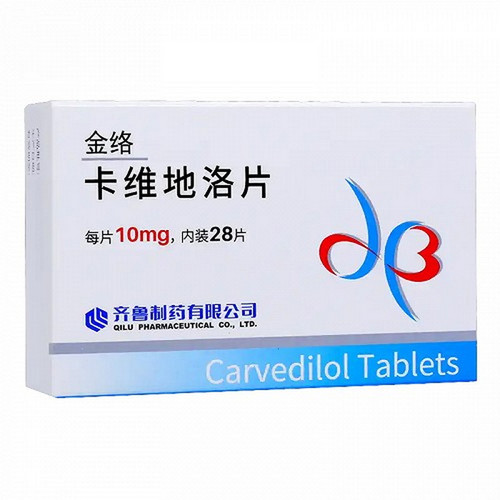Product Overview
[Drug Name]
Generic Name: Carvedilol Capsules
Trade Name: Kailuo
English Name: Carvedilol Capsules
Chinese Pinyin: Carvedilol Capsules
[Ingredients]
The main ingredient of this product is carvedilol, whose chemical name is (±)-1-(9-hydro-carbazole-4-oxy)-3-[[2-(2-methoxyphenoxy)ethyl]amino]-2-propanol.
[Properties]
This product is a capsule containing a white powder.
[Indications]
For the treatment of mild to moderate hypertension, it can be used alone or in combination with other antihypertensive drugs (especially thiazide diuretics).
[Dosage and Administration]
Oral: Due to significant individual variability, dosing should be done according to a physician's instructions. The recommended starting dose is 10 mg once daily. After two days, it can be increased to 10 mg twice daily. If the effect is still unsatisfactory after two weeks of use, it can be increased to 20 mg twice daily. The maximum daily dose should not exceed 40 mg.
[Adverse Reactions]
1. Neuropsychiatric system: Occasionally mild dizziness, headache and fatigue may occur, which are more likely to occur at the beginning of treatment. Depression and insomnia may occur in some cases.
2. Cardiovascular system: After the first dose, postural hypotension may occur occasionally, manifested as dizziness, blacking out, and transient syncope. Occasionally, there may be slow heartbeat, cold limbs, angina pectoris and atrioventricular block. Sometimes it may aggravate heart failure.
3. Digestive system: Occasionally, there may be gastrointestinal reactions, such as nausea, abdominal pain, diarrhea, constipation, and vomiting.
4. Respiratory system: Patients with a tendency to bronchospasm may experience dyspnea or asthma-like attacks, which may occasionally cause whooping cough-like wheezing, nasal congestion and dry oral mucosa.
5. Others: (1) Sometimes it may aggravate intermittent claudication and Raynaud's disease. (2) Occasional skin reactions (redness, itching, urticaria, lichen planus reactions)
[Contraindications]
1. Patients with severe heart failure. 2. Patients with allergic rhinitis, asthma and chronic obstructive pulmonary disease. 3. Patients with bradycardia, sinus syndrome, sinoatrial block, and Ⅱ-Ⅲ degree atrioventricular block. 4. Patients with shock, myocardial infarction and complications. 5. Patients with severe liver dysfunction. 6. Patients with diabetic ketoacidosis and metabolic acidosis. 7. Within 48 hours before surgery. 8. Patients who are allergic to this product.
[Precautions]
1. This product can mask the symptoms of hypoglycemia and induce hypoglycemia. Therefore, diabetic patients receiving hypoglycemic drugs should check their blood sugar regularly. 2. If you experience dizziness or syncope when standing up suddenly, you should remain sitting or lying down and consult a doctor. 3. If you experience dizziness or fatigue, you should avoid driving or engaging in dangerous work. 4. Do not adjust or discontinue medication without a doctor's consent. 5. When taking this drug, patients with thyrotoxicosis should not discontinue it abruptly. Instead, gradually reduce the dose and closely monitor symptoms. 6. When taking this drug, patients with pheochromocytoma should usually use it in combination with an alpha-blocker. 7. Patients with a personal or family history of psoriasis should use this drug with caution. 8. Patients with a history of severe allergies or those undergoing desensitization therapy should use this drug with caution.
[Precautions]
1. This drug can mask the symptoms of hypoglycemia and may induce hypoglycemia. Therefore, diabetic patients taking hypoglycemic medications should check their blood sugar regularly. 2. If you experience symptoms of hypotension such as dizziness or syncope after standing up suddenly, remain seated or lying down and consult a doctor. 3. If you experience dizziness or fatigue, avoid driving or engaging in hazardous work. 4. Do not adjust or discontinue medication without a doctor's consent. 5. When taking this drug, patients with thyrotoxicosis should not discontinue it abruptly. Instead, gradually reduce the dose and closely monitor symptoms. 6. When taking this drug, patients with pheochromocytoma should... Often used in combination with alpha-blockers. 7. Use with caution in patients with a personal or family history of psoriasis. 8. Use with caution in patients with a history of severe allergies or those undergoing desensitization therapy.
[Use in Pregnant and Lactating Women]
Contraindicated in pregnant women.
[Use in Special Populations]
Precautions for children: Not yet available.
Precautions for pregnancy and lactation: Not yet available.
Precautions for the elderly: Not yet available.
[Drug Interactions]
Drug interactions may occur if used concurrently with other medications. Please consult your physician or pharmacist for details.
[Pharmacological Actions]
Within the therapeutic dose range, carvedilol has both alpha- and non-selective beta-blocking properties and no intrinsic Sympathomimetic activity. This drug blocks α1 receptors on the postsynaptic membrane, thereby dilating blood vessels and reducing peripheral vascular resistance. It also blocks β receptors, inhibiting renal secretion and disrupting the renin-angiotensin-aldosterone system, resulting in a hypotensive effect. Carvedilol rapidly lowers blood pressure and maintains its effect for a long time. It has no effect on left ventricular ejection fraction, cardiac function, renal function, renal perfusion, peripheral blood flow, plasma electrolytes, or lipid levels. It does not affect heart rate or may slightly slow it, and rarely causes water and sodium retention.
[Storage] Protect from light, sealed.
[Strength] 10 mg
[Packaging Size] 10 mg x 24s/box
[Expiry Date] 24 months
[Approval Number] National Medicine Standard H20000568
[Manufacturer] Company Name: Peking University Pharmaceutical Co., Ltd.






